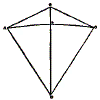By Dan Beard

Fig. 39.
The Eddy Kite.
Mr. William A. Eddy, of Bayonne, is also a celebrated kite enthusiast. He uses his kites for ascertaining how hot, cold, or damp it is up among the clouds. There is a vacant lot near his house where he flies his kites, or, to use a new term in vogue among these grownup kite-fliers, he dismisses a gang of kites " from the vacant lot.
Mr. Eddy is the proud owner of a "stable" of five hundred kites. He began his kite flying with the good old American hexagonal or coffin-shaped kite, but in using more than one kite on a string there was always a chance Of the tail becoming entangled in the line. At the Columbia Exposition he saw the Malay kite and that settled the tails. He now uses no kites with tails.

Fig. 40.
The Malay Kite.
How It is Made.
The following are his directions for building a kite as given in one of the New York papers:
"The longitudinal stick shown in the cut (Fig. 39), at the line B D should be of spruce about 3/8 by 1/2 inch. For ordinary purposes sixty inches is a convenient length, but it can be varied to any extent so long as the other dimensions are kept in proportion,. The cross piece A C should be a similar stick of equal length. When in position it is bent about four percent of its length. It should cross B D at E, so that B E shall be 19 percent of B D.
"The frame A B C D should be of light spruce, the same size as the cross-pieces, and great care should be used to have A B just equal to B C and A D equal to C D. When the frame is finished cover loosely with manila paper, allowing some concavity on the face of the kite on each side below the cross stick, so that it will act as a sail. Bind the edges with thin wire, which stretches less than string. Then go out and fly your kite. It will not e necessary to wait for the wind, for this kite will fly in a very slow breeze. If the kite is a large one, an important part is the string. It should have a breaking strength of from thirty to seventy-five pounds, in accordance with the strength of the winds it is used in. I any case not more than 1/3 of the breaking strain should be used, 2/3 being left as a reserve for emergencies. For very high flying silk cord is the best, as it possesses the greatest strength for its weight."
Seven Kites in Tandem.
Mr. Eddy sent up seven kites tandem that reached a height of 3,700 feet. This sort of kite-flying is not a boy's sport, at least not a small boy's sport, as the pull is often so great that no small boy could hold the kite, and sometimes it is dangerous, as another kite-flier, Mr. A. A. Merrill, discovered when the line of a large kite caught him around the waist. Fortunately, there was help near by, or the accident might have proved serious.
Among the things that will interest boys is the fact that Mr. Eddy has sent a camera up attached to his kite string, and by means of a line to pull, in place of reaching the button, he has taken photographs of the landscape from a kite's point of view. These were reproduced in a New York newspaper. To use the scientists' term let us now "dismiss" these airplanes and turn our attention for awhile to some novelties in the kite line, which will be less scientific, but just as interesting to the boys, and in the description of which we shall not have to use quotation marks, as the kites are our own invention.